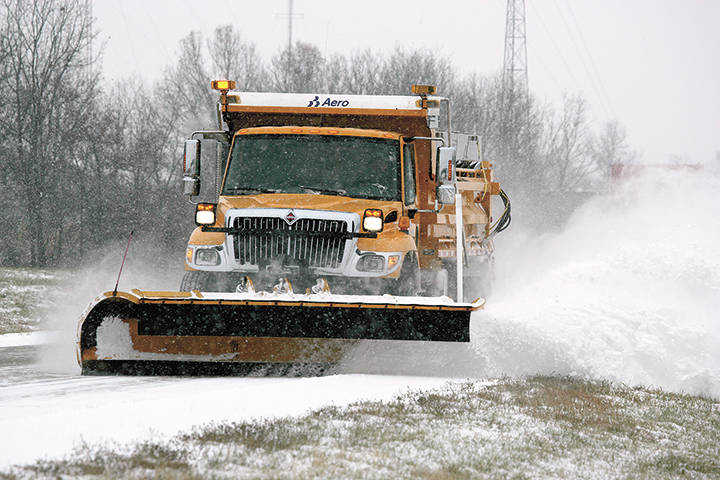MoDOT briefs LEPC on winter storm response

Alan Hooper, supervisor at the Missouri Department of Transportation facility in Nevada, gave Local Emergency Planning Committee members a briefing on MODOT’s winter storm response procedures for Vernon County.
“We stay on it 24/7 as long as the storm lasts,” Hooper said.
He explained the MODOT contingent in Nevada has 13 trucks equipped for snow removal and enough staff to operate two 12-hour shifts during a snowstorm. In the hours before a storm, crews will pre-treat major routes with a thawing product (salt) and trouble spots on minor routes.
“Once the snow storm starts we continue to push the snow — clear the snow — but do only a minimal amount of treating,” Hooper said.
While snow is still falling, only dangerous intersections, bridges and trouble spots are treated. This reduces the ineffective use of salt and controls costs.
“If we treat continually through a storm we basically waste a lot of salt product because we’re putting it out there and it’s just putting more ice and snow on top of it,” he said.
Once the snow stops, crews continue clearing snow from the roads, major routes first before clearing less important routes.
“As far as the routes and how the routes are ranked on what we treat first,” Hooper said. “We consider certain routes ‘major routes’ and that is all dictated by the traffic count.”
I-49 is considered a major route with more than 12,000-14,000 vehicles a day passing through the county.
During a snowstorm, six of Nevada’s 13 trucks are dedicated to keeping I-49 clear of snow — two in each of three loops, one in the driving lane and one in the passing lane.
US 54 Highway averages 5,000 vehicles per day and is also considered a major route. Other major routes include BB Highway from Austin Boulevard to FF Highway and W Highway north from Ash Street.
While 43 Highway is considered a major route, it has the lowest traffic volume of all the major routes.
“Those are the routes that we — according to state snow removal policy — those are the routes we concentrate on first,” Hooper said.
Once the snow stops and the major routes are cleared, minor routes such as AA Highway to Schell City, C Highway to Walker or B Highway out of Sheldon are tended to.
“For outlying communities, we try to get those roads busted out, if we have a big snow, as quick as we can,” he said.
Hooper said that according to state policy, minor routes are not completely treated — only curves, hills, intersections and bridges.
He continued, “We’ve had a couple ice storms in the last year and we treated — coast to coast we call it — we treated everything.”
He said MoDOT crews coordinate with troopers from Missouri State Highway Patrol to treat problem areas which are causing accidents.
“We have two trucks that stay here in Nevada,” he explained. “One stays on I-49 and works all the ramps and interchanges. Also in town, one constantly works down Austin.”
“Each storm is different,” Hooper said. “Some storms are easy to treat — snow is pretty easy. The last couple years, we’ve had a lot of ice. Ice is terrible — it’s hard to melt, it’s hard to stay on top of but we do the best we can.”
“We’ll work with the public,” Hooper said. “If there is a spot we need to try to get more, contact us and well do what we can.”
For current information on road conditions statewide visit the MoDOT Traveler’s Map at http://traveler.modot.org/map/.
In other business:
• Outgoing Emergency Management Director Dennis Kimrey introduced incoming Emergency Management Director Chris Haynes. Haynes takes over leadership of Vernon County Emergency Management on Jan. 1, 2018.
• Mike Ast was nominated for vice-chair. The election will be held at the January meeting.
